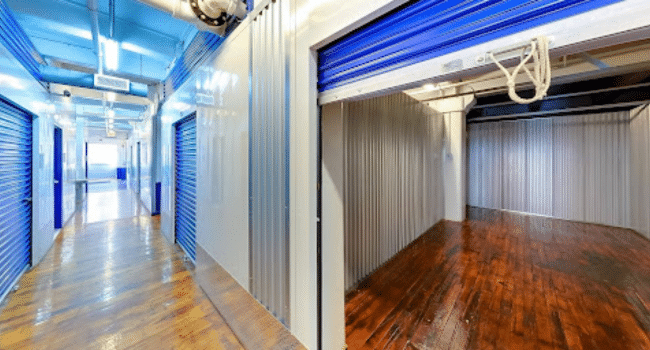Table of Contents
When you’re looking for a place to store your items, one of the first decisions you’ll need to make is whether to choose a climate-controlled storage unit or a regular one. Both options have their advantages, but understanding the key differences can help you make the best choice based on your needs. In this article, we’ll break down what climate-controlled storage is, what regular storage units offer, and guide you in choosing the right type of storage for your belongings.
What is Climate-Controlled Storage?
Climate-controlled storage units are designed to protect sensitive items from extreme temperature fluctuations and humidity. These units maintain a consistent environment, typically between 55°F and 85°F (13°C to 29°C), with low humidity levels. This is particularly important for storing items that can be damaged by heat, cold, or moisture.
Ideal Items for Climate-Controlled Storage
Some items are more vulnerable to environmental changes and should be stored in a climate-controlled unit. These include:
- Electronics: Electronics such as computers, televisions, and sound systems can be damaged by temperature extremes or moisture.
- Furniture: Wooden and leather furniture can warp or crack if exposed to heat or humidity.
- Documents and Photographs: Paper can deteriorate, fade, or become moldy when exposed to excessive moisture or heat.
- Artwork: Paintings and sculptures, especially those made from materials like canvas or clay, are highly sensitive to temperature and humidity.
- Musical Instruments: Instruments like pianos, violins, and guitars can be affected by changes in temperature or moisture, causing warping, cracking, or other types of damage.
What is Regular Storage?
Regular storage units, on the other hand, offer a standard, non-climate-controlled environment. These units do not regulate temperature or humidity, which means that the conditions inside the unit can vary depending on the time of year and location. Regular storage units are typically more affordable than climate-controlled units and are often used for items that aren’t as sensitive to environmental changes.
Ideal Items for Regular Storage
Many everyday items can be safely stored in regular units without the risk of damage. These include:
- Seasonal Clothing: Items like winter coats or summer clothes are generally safe in regular storage, as they’re designed to withstand a range of temperatures.
- Tools and Equipment: Non-electronic tools and outdoor equipment (e.g., lawnmowers, bicycles, etc.) are typically durable and can handle temperature fluctuations.
- Books and Magazines: While paper can be sensitive to moisture, well-sealed boxes of books or magazines are often fine in regular storage.
- Home Appliances: Large appliances such as refrigerators, washing machines, and dryers don’t require a climate-controlled environment, although it’s important to ensure they’re properly cleaned and dried before storage.
- Non-Perishable Food: If you need to store food items that are not susceptible to heat (e.g., canned goods), regular storage is usually sufficient.
Factors to Consider When Choosing Between Climate-Controlled and Regular Storage
When deciding between climate-controlled and regular storage, consider the following factors:
1. Type of Items You’re Storing
As discussed, some items are more sensitive to temperature and humidity than others. If you’re storing items like electronics, artwork, or furniture, a climate-controlled unit is a must to prevent potential damage. On the other hand, if you’re storing durable, non-sensitive items like tools or seasonal clothing, a regular unit will suffice.
2. Location and Climate
The climate in your area is another important factor to consider. If you live in a place with extreme temperatures (hot summers or cold winters), climate-controlled storage may be necessary to protect your items. On the other hand, if you live in a more temperate region where temperature fluctuations are less of a concern, regular storage could be enough.
For instance, if you’re in need of storage options in a warmer or more humid region, like Miami, you might want to consider Storage units Miami, as climate control can make a big difference in protecting your belongings.
3. Duration of Storage
How long you plan to store your items is another key consideration. For short-term storage, regular units may be fine, especially if the items you’re storing are not sensitive to the environment. However, if you plan to store items for a longer period (e.g., several months or years), climate-controlled storage may be a better investment to preserve the condition of your items.
4. Budget
Climate-controlled units tend to be more expensive than regular storage units due to the additional maintenance required to regulate the environment. If you’re working with a tight budget and don’t need climate control, a regular storage unit will be a more affordable option. However, if the items you need to store are particularly valuable or sensitive, the added cost of a climate-controlled unit may be worth it to ensure their protection.
Conclusion
Ultimately, the choice between climate-controlled and regular storage comes down to the types of items you’re storing, the local climate, how long you’ll need storage, and your budget. If you have sensitive items that could be damaged by heat, cold, or moisture, a climate-controlled unit is the safest choice. For everyday items that are durable and less sensitive, a regular storage unit will likely meet your needs at a lower cost.
Before making your decision, assess your needs carefully and choose the storage option that best protects your belongings. If you opt for a standard unit, you can rest assured that your items will be stored safely and securely.
